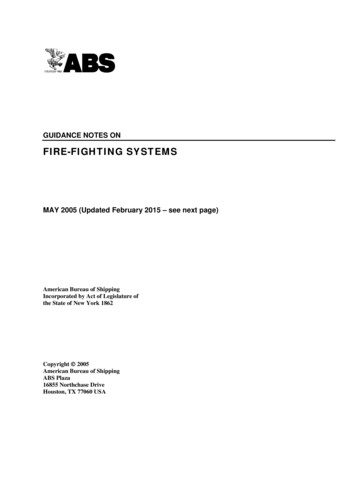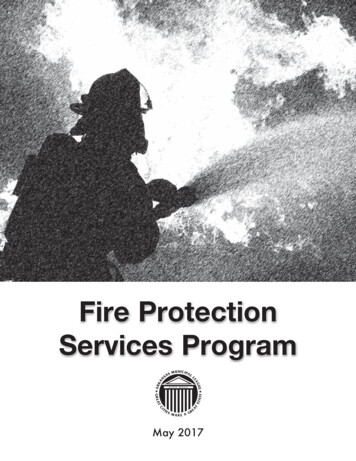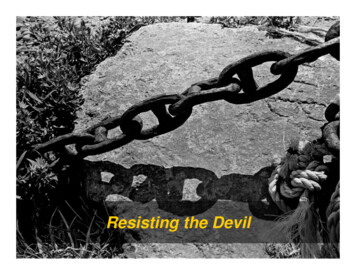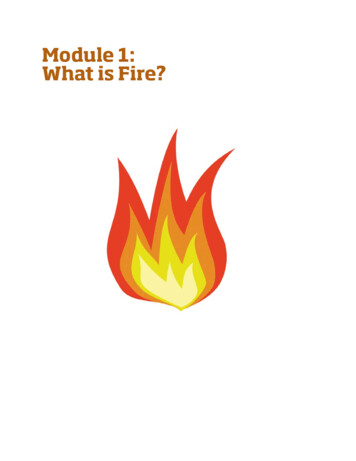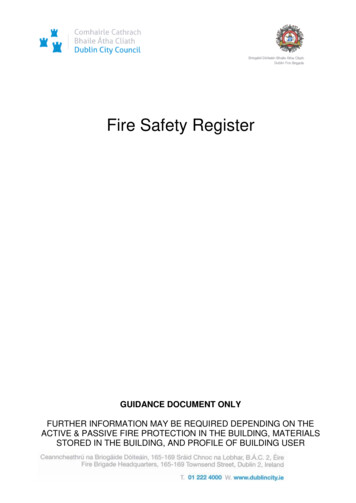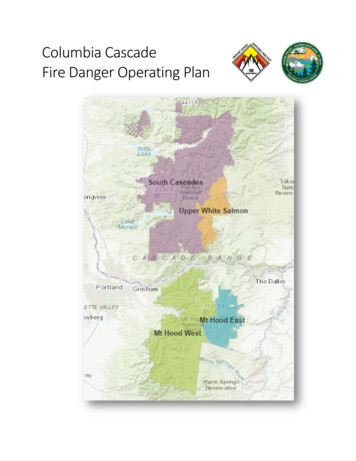
Transcription
Guidance Notes on Fire-Fighting SystemsGUIDANCE NOTES ONFIRE-FIGHTING SYSTEMSJANUARY 2017American Bureau of ShippingIncorporated by Act of Legislature ofthe State of New York 1862 2016 American Bureau of Shipping. All rights reserved.ABS Plaza16855 Northchase DriveHouston, TX 77060 USA
ForewordForeword (2017)PurposeThe ABS Rules incorporate many requirements intended to prevent the onset of a fire. However, evenwith all the preventative measures taken, shipboard fires still occur. Therefore, the proper design, installationand operation of the vessel’s fire-fighting systems are critical to the safety of a vessel and the personnel onboard.Since fire-fighting systems are so critical, the designs and arrangements of such systems should be carefullyevaluated for compliance with the ABS requirements by the designer and ABS Engineering staffs. TheseGuidance Notes have been developed to assist in a better understanding of the ABS requirements for suchsystems. They are intended to provide a general overview of ABS requirements that should be consideredduring technical plan review activities. These Guidance Notes also examine the basic scientific fundamentalsof fire, as appropriate for a proper understanding and application of the ABS requirements. Accordingly,this document should be considered as general guidance only and the technical reviews of fire-fightingsystems should verify compliance with all ABS Rules applicable to the specific vessel involved.Note:Rule references in these Guidance Notes (e.g. 4-7-2/1.1.1, etc.) are typically to the requirements found in the ABSRules for Building and Classing Steel Vessels, unless noted otherwise.ScopeThe scope of this document is limited to the review of ABS requirements considered during the technicalplan review of active fire-fighting systems onboard ABS-classed vessels. Passive fire protection arrangements,such as structural fire protection, as well as fire detection systems, are outside the scope of this document.Fire-fighting systems of offshore facilities and installations are also outside the scope of this document.The review of fire-fighting systems for the International Maritime Organization’s (IMO’s) InternationalConvention for the Safety of Life at Sea (SOLAS) requirements is also not within the scope of this document.However, in many cases, the ABS Rules for fire-fighting systems either incorporate or directly referenceIMO SOLAS fire-fighting system requirements. Accordingly, within the discussions of the ABS requirementsfor various fire-fighting systems, related “interpretations” of the associated SOLAS requirements, as developedby the International Association of Classification Societies (IACS), are identified. These IACS interpretationsare called Unified Interpretations (UI). As an IACS member, ABS is obligated to apply these UIs as appropriateinterpretations of the SOLAS requirements, unless directed otherwise by the Flag Administration.Interpretations provided in the UIs should be considered when conducting technical plan reviews.Note:Development of appropriate Unified Interpretations and revision of existing UIs is an ongoing effort within theIACS Working Parties. Therefore, attention is directed to the latest edition of the IACS UI being available on thewebsite http://www.iacs.org.uk/publicationsIn addition to the IACS UIs, IMO MSC Circular 1120 “Unified Interpretations of SOLAS Chapter II-2, theFSS Code, the FTP Code and related Fire Test Procedures” (and its subsequent correction (Corr.1) andamendments per MSC.1 Circulars 1436, 1491 and 1510) also provides guidance regarding SOLAS firefighting system requirements. Many of the MSC Circular 1120 interpretations are based upon the IACSUI interpretations, while others provide revised or additional interpretations of the SOLAS requirements.A number of the MSC Circular interpretations have been included in the SOLAS 2000 consolidated editionand subsequently in the SOLAS Consolidated Editions 2004, 2009 and 2014. Consequently, these requirementswere also incorporated into the ABS Rules. However, since the MSC Circulars interpretations identifyuseful information and guidance relative to certain Rule requirements, “selected” IMO MSC interpretationshave also been identified.Note:iiRegarding classification requirements, MSC Circulars interpretations which are not included within SOLAS have notnecessarily been officially adopted by ABS and should only be applied as directed by the ABS Chief Engineer’sOffice. Further, MSC Circulars interpretations may not be mandatory for any particular Flag Administration, exceptfor those incorporated within SOLAS. Member Governments are only invited to use the annexed interpretations asguidance, and therefore, specific instructions from the ABS Regulatory Affairs Department should be obtainedregarding the application of these interpretations on behalf of any particular Administration.ABS GUIDANCE NOTES ON FIRE-FIGHTING SYSTEMS . 2017
Table of ContentsGUIDANCE NOTES ONFIRE-FIGHTING SYSTEMSCONTENTSSECTION 1Basics of a Fire . 11Chemistry of Fire. 1Oxidation . 11.2State of Products in “Fire” Oxidation Process. 12Fundamentals of a Fire . 23The Fire Triangle. 23.1Fuel . 33.2Oxygen . 43.3Heat . 54The Fire Tetrahedron . 55Extinguishment Considering the Fire Tetrahedron . 56SECTION 21.15.1Removing the Fuel . 65.2Removing the Oxygen . 65.3Eliminating the Heat . 65.4Breaking the Chain Reaction . 7Hazardous/Combustible Materials . 76.1Flames. 76.2Heat . 76.3Gases . 86.4Smoke . 8FIGURE 1The Fire Triangle . 2FIGURE 2The Fire Tetrahedron . 5Classification of Fires . 91Overview . 92Class “A” Fires . 1032.1Wood and Wood-based Materials . 102.2Textiles and Fibers . 112.3Plastics and Rubber . 122.4Locations of Class “A” Materials Onboard . 132.5Extinguishment of Class “A” Fires . 14Class “B” Fires . 143.1Flammable Liquids . 143.2Flammable Gases . 16ABS GUIDANCE NOTES ON FIRE-FIGHTING SYSTEMS . 2017iii
456Class “C” Fires .184.1Types of Equipment . 184.2Electrical Faults that Cause Fires . 194.3Hazards of Electrical Fires . 194.4Locations of Electrical Equipment Onboard . 194.5Extinguishment of Class “C” Fires . 20Class “D” Fires .205.1Hazards/Characteristics of Specific Metals . 205.2Locations of Class “D” Materials Onboard . 215.3Extinguishment of Class “D” Fires . 21Class “K” or “F” Fires .216.1Hazards/Characteristics of Fires Caused by Cooking Grease,Fats and Oils . 216.2Location of Cooking Grease, Fats and Oils Onboard . 226.3Extinguishment of Class “K” or “F” Fires . 22TABLE 1Fire Classifications .9TABLE 2 Burning Characteristics of Synthetic Fibers .12SECTION 3Fire Main Systems . 241General Principles of the Fire Main System .242Extinguishing Capabilities of Water .243Moving Water to the Fire.244iv3.1Straight Streams . 253.2Fog Streams . 28ABS Requirements for Fire Main Systems .304.1Main Fire Pumps. 304.2Emergency Fire Pump . 334.3Fire Main Sizing and System Pressures . 364.4Fire Hose Reaction . 384.5Isolation Valves and Routing Arrangements . 384.6Fire Main Piping Components/Materials . 384.7Hydrant Locations and Fire Hoses/Nozzles . 394.8International Shore Connection Arrangements . 414.9Cold Weather Protection . 414.10Additional Requirements for Vessels with AutomationNotations . 424.11Alternative Requirements for Steel Vessels Under 90 Meters inLength and less than 1000 Gross Tons . 424.12Additional Requirements for Oil and Fuel Oil Carriers . 424.13Additional Requirements for Passenger Vessels . 434.14Additional/Alternative Requirements for Ro-Ro Vessels . 454.15Additional/Alternative Requirements for Gas Carriers . 454.16Steel Vessels Under 90 Meters (295 feet) in Length . 464.17High-Speed Craft . 484.18Cargo Vessels for River Service . 504.19Additional Requirements for Passenger Vessels in RiverService . 52ABS GUIDANCE NOTES ON FIRE-FIGHTING SYSTEMS . 2017
SECTION 4Yachts . 524.21Fishing Vessels . 534.22Accommodation Barges . 534.23Offshore Support Vessels. 55TABLE 1Water Discharge Rates . 26TABLE 2Horizontal Reach of Water Streams . 27TABLE 3Dimensions of International Shore Connection . 41TABLE 4Cross-reference of Under 90 Meter Rules Requirements . 47TABLE 5Pump Capacities . 47Fixed Gas Fire-extinguishing Systems . 571Principles of Fixed Gas Fire-extinguishing Systems . 572CO2 Fire-extinguishing Systems . 573SECTION 54.202.1Agent Characteristics . 572.2Effectiveness . 572.3CO2 System Applications . 58ABS Requirements for Fixed Gas Extinguishing Systems . 583.1General Requirements . 583.2Additional Requirements for Fixed CO2 Gas Extinguishing Systems. 643.3Additional Control Requirements for CO2 Systems . 673.4Additional Requirements for Low Pressure CO2 Systems . 673.5Additional Requirements for Vessels Receiving an “ACCU”Automation Notation . 693.6Governmental Authorization . 703.7Steam Smothering Systems . 703.8Halon Systems . 703.9Requirements for Systems using Halon “Alternatives” . 703.10Additional/Alternative Requirements for Special Locations . 71TABLE 1Minimum Pipe Wall Thickness of Gas Medium DistributionPiping . 60TABLE 2CO2 Requirements . 65Fixed Water Fire-extinguishing Systems . 731General Principles of Fixed Water Fire-extinguishing Systems. 7321.1Water Spray System . 731.2Water Sprinkler Systems . 741.3Water Mist Systems . 74ABS Requirements for Fixed Water Spray, Water Sprinkler, andWater Mist Systems . 752.1General System Component Requirements . 752.2Fixed Water Spray Systems in Machinery Spaces . 762.3Fixed Water Sprinkler Systems in Accommodation Spaces . 782.4Fixed Water Spray Systems in Ro-Ro Spaces . 822.5Fixed Water Mist Systems in Machinery Spaces and CargoPump Rooms. 83ABS GUIDANCE NOTES ON FIRE-FIGHTING SYSTEMS . 2017v
SECTION 6Fixed Water Mist Systems in Accommodation and ServiceSpaces . 872.7Fixed Pressure Water-Spraying Fire Extinguishing System onCabin Balconies of Passenger Ships . 92Foam Fire-extinguishing Systems . 931Foam .932General Principals of Foam Extinguishing Systems .933SECTION 72.62.1Extinguishing Effects of Foam . 932.2Foam Characteristics . 932.3Types of Foams . 942.4Limitations on the Use of Foam . 962.5Advantages of Foam. 962.6Basic Guidelines for Foam . 972.7Foam System Equipment . 972.8Foam Fire-Fighting Application Techniques . 100ABS Requirements for Foam Extinguishing Systems.1013.1General Requirements Applicable to All Foam Systems . 1013.2Additional Requirements for “Oil Carrier” Deck Foam Systems . 1023.3Additional Requirements for “Chemical Carrier” Deck FoamSystems . 1063.4Additional Requirements for Fixed High Expansion FoamSystems in Machinery Spaces . 1113.5Additional Requirements for Supplementary Fixed LowExpansion Foam Systems in Machinery Spaces . 1123.6Additional Requirements for Helicopter Landing Facilities . 112TABLE 1System Capacity .113FIGURE 1Calculation of Foam System Capacity – Oil Carrier .105FIGURE 2Calculation of Foam System Capacity – ChemicalTankers .109Gas Carrier Cargo Area Fire-extinguishing Systems . 1141Unique Hazards of Fires Onboard Gas Carriers.1141.122.13Extinguishing Effects of Dry Chemical . 115ABS Requirements for Fire-Fighting Systems Onboard GasCarriers .1163.1Dry Chemical Powder Fire Extinguishing Systems . 1163.2Cargo Area Water Spray Systems . 1183.3Fire Main System . 1193.4Enclosed Spaces Containing Cargo Handling Equipment . 119TABLE 1viFlammability . 114General Principles of Cargo Deck Dry Chemical ExtinguishingSystem .115Fixed Monitor Requirements .116ABS GUIDANCE NOTES ON FIRE-FIGHTING SYSTEMS . 2017
SECTION 8Portable/Semi-portable Fire Extinguishers . 1201Portable and Semi-portable Fire Extinguishers . 12021.1Water-type Fire Extinguishers . 1201.2Foam-type Fire Extinguishers. 1221.3Carbon Dioxide (CO2) Fire Extinguishers . 1231.4Dry Chemical-type Fire Extinguishers . 1231.5Dry Powder-type Fire Extinguishers . 1241.6Wet Chemical-type Fire Extinguishers . 1251.7Portable Fire Extinguishers . 1251.8Semi-portable Fire Extinguishers . 1261.9Fire Extinguisher Designations . 126ABS Requirements for Portable/Semi-portable FireExtinguishers . 1262.1Sizing of Portable Extinguishers . 1262.2Approval of Portable and Semi-portable Extinguishers . 1272.3Spaces Containing Boilers (Main or Auxiliary), Oil-firedEquipment . 1272.4Category “A” Machinery Spaces Containing InternalCombustion Machinery . 1292.5Combined Boiler and Internal Combustion Engine MachinerySpaces . 1292.6Spaces Containing Steam Turbines or Steam Engines . 1302.7Portable/Semi-portable Fire Extinguishers in Other MachinerySpaces . 1312.8Accommodations, Service Spaces and Control Stations . 1312.9Fire Protection Arrangements for Paint Lockers . 1332.10Fire Protection Arrangements for Helicopter Landing Areas . 1332.11Vessels with Automation Designation “ACCU” . 1332.12Additional Requirements for Ro-Ro Spaces, Ro-Ro SpacesCarrying Motor Vehicles with Fuel in Their Tanks, andCargo Spaces Carrying Motor Vehicles with Fuel inTheir Tanks (other than Ro-Ro Spaces) . 1332.13Additional Requirements for Vessels Carrying DangerousGoods . 1342.14Additional Requirements for Chemical Carriers. 1342.15Vessels Under 90 Meters (295 Feet) . 1342.16Oil Carriers Under 30.5 Meters (100 Feet) . 1352.17Spare Charges . 135TABLE 1Portable/Semi-portable Extinguisher Classifications . 126TABLE 2Spaces Containing Boilers or Oil-fired Equipment. 128TABLE 3Combined Boiler/Internal Combustion Engine MachinerySpaces . 130TABLE 4Portable/Semi-portable Extinguishers – Vessels Under90 meters . 134ABS GUIDANCE NOTES ON FIRE-FIGHTING SYSTEMS . 2017vii
SECTION 9Additional Fire Protection Requirements . 1361Segregation of Fuel Oil Purifiers for Heated Oil.1362Segregation of High Pressure Hydraulic Units .1373Requirements for Piping Systems Handling Oil .13743.1Material Requirements for Piping Systems Conveying Oil . 1373.2Remote Closure Arrangements for Valves on Oil Tanks . 1373.3Fuel Oil and Lube Oil Systems on Engines . 1373.4Insulation Requirements for Heated Surfaces . 1383.5Remote Stopping of Fuel Oil Pumps and Thermal FluidCirculating Pumps. 1383.6Remote Stops for Ventilation Fans and Closing Arrangementsfor Openings . 138Paint/Flammable Liquid Lockers .1384.1Lockers of 4 m2 (43 ft2) and More Floor Area . 1384.2Lockers of Less Than 4 m2 (43 ft2) Floor Area . 139SECTION 10 Fire Control Plans. 1401Standardized Symbols .1402ABS Requirements for Fire Control Plans .1402.1Steel Vessels 90 Meters in Length and Greater in UnrestrictedService . 1402.2Vessels with Automation Designation “ACC” . 1462.3Vessels with Automation Designation “ACCU” . 1472.4Additional Requirements for Vessels Carrying DangerousGoods . 1482.5Additional Requirements for Vessels Carrying Bulk Oil . 1482.6Additional Requirements for Gas Carriers . 1492.7Additional Requirements for Chemical Carriers . 1502.8Additional Requirements for Passenger Vessels . 1502.9Additional Requirements for Ro-Ro Spaces . 1522.10Additional Requirements for Cargo Spaces, Other Than Ro-RoCargo Spaces, Intended to Carry Vehicles with Fuel in TheirTanks . 1532.11Vessels Under 500 Gross Tons . 1532.12Barges . 153TABLE 1Minimum Number of Required EEBDs .145APPENDIX 1 References . 154viiiABS GUIDANCE NOTES ON FIRE-FIGHTING SYSTEMS . 2017
Section 1: Basics of a FireSECTION1Basics of a FireFire is a phenomenon with which everyone is familiar. We use it daily to heat our homes and cook ourmeals. When harnessed, the power and energy from fire serves us well; however, when it is uncontrolled,a fire can quickly consume and destroy whatever lies in its path.While we are all familiar with fire, few of us are aware of its nature and complex processes. This Sectionexamines the phenomena and various mechanisms at work within a fire and is intended to provide a betterunderstanding of the requirements in fire-fighting scenarios.1Chemistry of Fire1.1OxidationOxidation is a chemical reaction between the molecules of a substance and the oxygen molecules in thesurrounding atmosphere. There are many common examples of oxidation, including the rusting of iron,the tarnishing of silver, or the rotting of wood.What is known as fire is actually a chemical reaction involving the oxidation of the fuel molecules. However,the reaction occurs at a much faster rate and only under certain conditions (e.g., elevated temperatures,proper mixture, etc.). In addition, what is called burning or combustion is actually the continuous rapidoxidation of millions of fuel molecules. Recognizing that the fire or combustion process is actually a chemicalreaction (involving the oxidation of the fuel molecules) is critical to understanding the basics of the firephenomena.The oxidation reaction is an exothermic process (i.e., one in which heat is given off). The molecules oxidizeby breaking apart into individual atoms and recombine with the oxygen atoms to form new molecules.During this process, a certain amount of energy is released. In the examples of rusting iron or rotting wood,the amount of energy released is minimal since these oxidation processes occur at a very slow rate. Howeverin a fire, the oxidation rate of the fuel molecules is much faster. Because of this rapid reaction, energy isreleased at a much greater rate. The released energy is actually felt and seen in the form of heat and light.The more rapid the oxidation rate, the greater intensity in which the energy is released. An explosion is, infact, the oxidation of a combustible media at an extremely fast rate.1.2State of Products in “Fire” Oxidation ProcessAll substances exist in one of three states: as a solid, a liquid or a vapor (gas). For the oxidation process tooccur, there must be an adequate intermixing of the oxygen and fuel molecules. For fuel molecules in eithera solid or liquid state, the molecules are tightly bound and cannot be effectively surrounded by the oxygenmolecules in the atmosphere. Therefore, molecules in either a liquid or solid state are not directly involvedin the rapid chemical reaction of oxidation in a fire.However, fuel molecules in a vapor state are free to mix with the atmosphere. These molecules becomeeffectively surrounded by the oxygen molecules in the atmosphere and are available to become involved in theoxidation process. In fact, only fuel molecules in a vapor state are actually involved in the oxidation process.While fuel molecules in the solid or liquid states are not directly involved in the oxidation process, whenheated, these molecules will move about more rapidly. If enough heat (energy) is applied, some fuelmolecules break away from the surface to form a vapor just above the surface. This new vapor can nowmix with oxygen and can become involved in the oxidation process. Accordingly, the fuel molecules in asolid or liquid state do serve as the source of additional fuel vapors when exposed to heat.Note:Usually, molecules in a liquid state can break free more easily than those in a solid state. In many cases, little orno additional heat is necessary for at least some of the
such as structural fire protection, as well as fire detection systems, are outside the scope of this document. Fire-fighting systems of offshore facilities and installations are also outside the scope of this document. The review of fire-fighting systems for the International Maritime Organization's (IMO's) International
